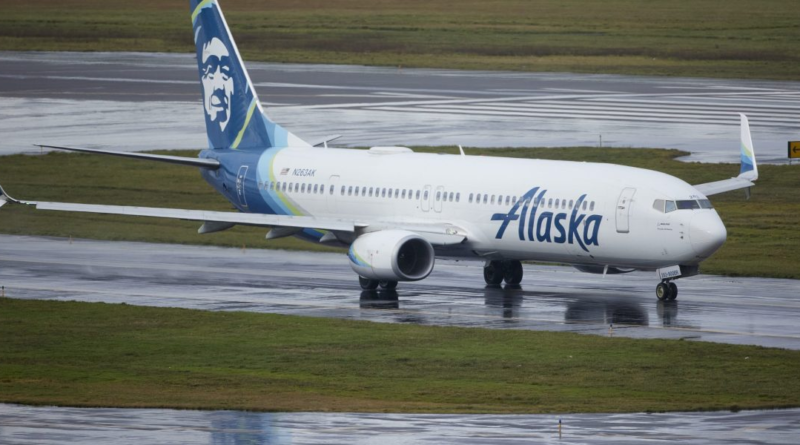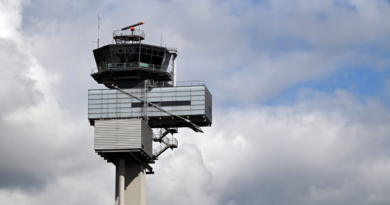Alaska Airlines grounds all its Boeing 737 Max 9 jetliners one day after returning 18 to service
Alaska Airlines again grounded all of its Boeing 737 Max 9 jetliners on Sunday after federal officials indicated further maintenance might be required to assure that another inflight blowout like the one that damaged one of its planes doesn’t happen again.
The airline had returned 18 of its 65 737 Max 9 aircraft to service on Saturday following inspections that came less than 24 hours after a portion of one plane’s fuselage blew out three miles above (4.8 kilometers) above Oregon on Friday night. The depressurized plane, which was carrying 171 passengers and six crew members, returned safely to Portland International Airport with no serious injuries.
The airline said in a statement that the decision was made after receiving a notice from the Federal Aviation Administration that additional work might be needed. Other versions of the 737 are not affected.
“These aircraft have now also been pulled from service until details about possible additional maintenance work are confirmed with the FAA. We are in touch with the FAA to determine what, if any, further work is required before these aircraft are returned to service,” the airline said.
The FAA had ordered the grounding of some 737 Max 9s on Saturday until they could be inspected, a process that takes about four hours. The world’s airlines are currently operating about 171 737 Max 9s globally.
The aircraft make up about 20% of the Alaska Airlines’ fleet. As of midday, Alaska had canceled about a fifth of its Sunday flights, according to FlightAware.com. United Airlines, which also grounded its Max 9s, had about a 10% cancellation rate on Sunday.
The National Transportation Safety Board is investigating Friday’s accident and is still looking for the door from the paneled-over exit that blew out. They have a good idea of where it landed, near Oregon Route 217 and Barnes Road in the Cedar Hills area west of Portland, NTSB Chair Jennifer Homendy said at a news conference late Saturday.
“If you find that, please, please contact local law enforcement,” she said.
It was extremely lucky that the airplane had not yet reached cruising altitude, when passengers and flight attendants might be walking around the cabin, Homendy said.
“No one was seated in 26A and B where that door plug is, the aircraft was around 16,000 feet and only 10 minutes out from the airport when the door blew,” she said. The investigation is expected to take months.
There has not been a major crash involving a U.S. passenger carrier within the country since 2009 when a Colgan Air flight crashed near Buffalo, New York, killing all 49 people on board and one person on the ground. In 2013, an Asiana Airlines flight arriving from South Korea crashed at San Francisco International Airport, killing three of the 307 people on board.
Flight 1282 took off from Portland at 5:07 p.m. Friday for a two-hour flight to Ontario, California. About six minutes later, the chunk of the fuselage blew out as the plane was at about 16,000 feet (4.8 kilometers). One of the pilots declared an emergency and asked for clearance to descend to 10,000 feet (3 kilometers), the altitude where the air would have enough oxygen to breathe safely.
Videos posted by passengers online showed a gaping hole where the paneled-over exit had been and passengers wearing masks. They applauded when the plane landed safely about 13 minutes after the blowout. Firefighters then came down the aisle, asking passengers to remain in their seats as they treated the injured.
The aircraft involved rolled off the assembly line and received its certification two months ago, according to online FAA records. It had been on 145 flights since entering commercial service Nov. 11, said FlightRadar24, another tracking service. The flight from Portland was the aircraft’s third of the day.
Aviation experts were stunned that a piece would fly off a new aircraft. Anthony Brickhouse, a professor of aerospace safety at Embry-Riddle Aeronautical University, said he has seen panels of fuselage come off planes before, but couldn’t recall one where passengers “are looking at the lights of the city.”
He said the incident is a reminder for passengers to stay buckled in.
“If there had been a passenger in that window seat who just happened to have their seat belt off, we’d be looking at a totally different news story.”
The Max is the newest version of Boeing’s venerable 737, a twin-engine, single-aisle plane frequently used on U.S. domestic flights. The plane went into service in May 2017.
The president of the union representing flight attendants at 19 airlines, including Alaska Airlines, commended the crew for keeping passengers safe.
“Flight Attendants are trained for emergencies and we work every flight for aviation safety first and foremost,” Sara Nelson, president of the Association of Flight Attendants, said in a statement Saturday.
Two Max 8 jets crashed in 2018 and 2019, killing 346 people and leading to a near two-year worldwide grounding of all Max 8 and Max 9 planes. They returned to service only after Boeing made changes to an automated flight control system implicated in the crashes.
Last year, the FAA told pilots to limit use of an anti-ice system on the Max in dry conditions because of concern that inlets around the engines could overheat and break away, possibly striking the plane.
Max deliveries have been interrupted at times to fix manufacturing flaws. The company told airlines in December to inspect the planes for a possible loose bolt in the rudder-control system.
___
Koenig reported from Dallas. Bohrer reported from Juneau, Alaska. Associated Press reporters Terry Spencer in Fort Lauderdale, Florida, and Audrey McAvoy in Honolulu, Hawaii, contributed.




